Growing Kohlrabi is not the most challenging thing in the world because Kohlrabi is somewhat easier to grow. The Kohlrabi plant is a rapidly growing and often overlooked treasure to grow in a vegetable garden. This Brassica gem is rising in interest among gardeners for a good reason. Kohlrabi provides sweet, crispy, juicy crops from garden to table when planting and growing conditions are optimal.
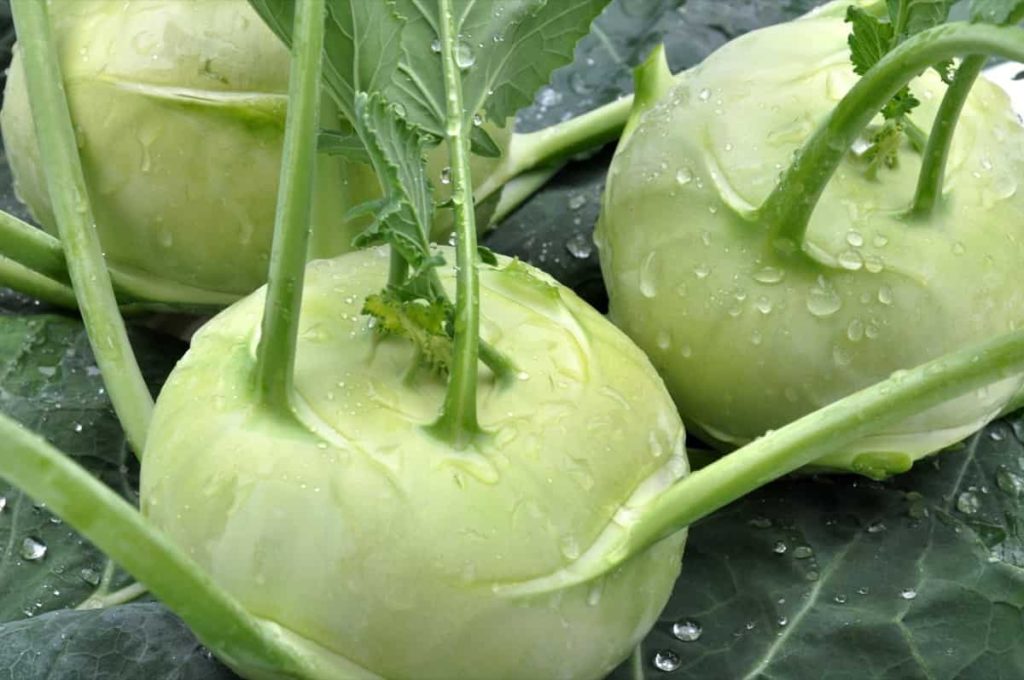
How to grow Kohlrabi from seed to harvest
How long does it take for Kohlrabi to mature from seed?
- It’s an easy process to start Kohlrabi from seeds. Because it’s a cold-season vegetable, Kohlrabi seeds should start in early spring or autumn. Wait to start Kohlrabi seeds until the soil temperature reaches at least 7°C, although the seeds will normally grow if the soil temperature is as low as 4°C. Saved seeds are usually viable for up to 4 years.
- Sow several times directly during the four to six weeks after the last frost date for the crop to mature in about eight weeks. Sow again from mid-July to early August for autumn and winter crops. Planting between mid-May and mid-July grows the Kohlrabi in hot weather, resulting in fewer bulbs.
- The seedlings will emerge within 4 to 7 days and should be thin at a distance of 4 to 6 inches in a row. Depending on the variety, Kohlrabi planting will be ready for 40 to 60 days (8 weeks) to harvest.
Does Kohlrabi grow above ground or below ground?
- Kohlrabi is grown for its swollen base and plant stem. Kohlrabi is a good choice for gardeners whose having shallow soils because its base is shaped like a globe and grows above the ground.
- The plant prefers cold weather, so fall is preferred if you can grow only one crop in the season. It will taste good if it matures in the fall. Kohlrabi is not a root plant; the bulb is the plant’s stem and should sit just above the soil’s surface. This part of the root will swell and become a sweet, tender vegetable that you can cook or eat raw.
How many Kohlrabi do you get from one plant?
- The part of Kohlrabi for harvesting is the wide, swollen part of the stem that forms just above the surface of the soil. Some call it a bulb because it looks like sitting on top of the soil. But it is normally called a swollen stem instead of a bulb.
- The swollen stem is not the only edible part of the plant. You can also eat vegetable leaves that form on top. You will get one Kohlrabi per plant. You can achieve an average yield of 300 quintals per hectare.
In case you missed it: Kohlrabi Gardening For Beginners, How To Start
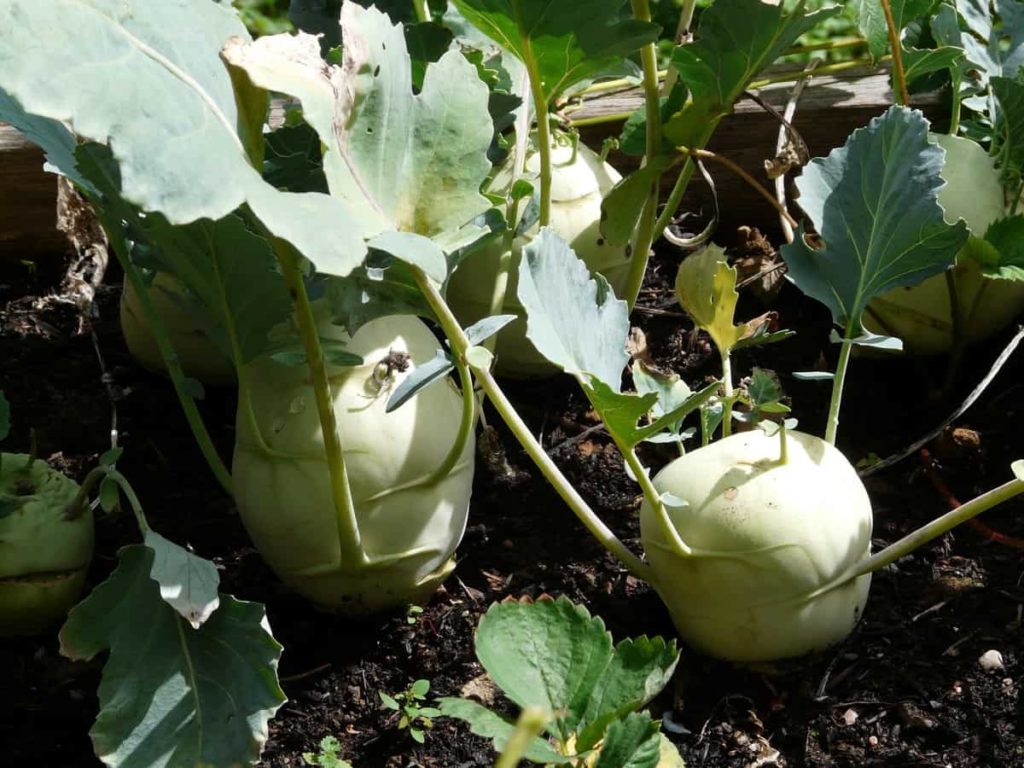
How late can you plant Kohlrabi?
- You can directly seed Kohlrabi in the garden from mid-April to early May and then after July. Avoid Kohlrabi, where you have grown related crops Broccoli, Cauliflower, Collard, Kale, Turnip, Rutabaga, Cabbage, Mustard, Bok choy, and Brussels Sprout over the past four years.
- Sow Kohlrabi seeds in the garden 3 to 4 weeks before spring’s last average frost date. Kohlrabi grows best in cold temperatures between 4.4°C and 23.9°C. Kohlrabi can take 45 to 60 days to reach maturity. Sow Kohlrabi in late summer harvesting in warmer winter areas.
- In spring, once the soil temperature is at least 7°C, seeds are directly sown in the garden for early to mid-summer harvest.
- To start indoors, sow seeds 6 to 8 weeks before your last spring frost date. Also, harden the seedlings before planting outside.
Does Kohlrabi grow in winter?
- Kohlrabi can be cultivated throughout the year in mild winter regions. The best time to sow Kohlrabi for a winter crop is late summer. Kohlrabi can compete with frost in the early autumn. In the colder areas of winter, sow Kohlrabi in the summer for an early fall crop.
- Warm summer temperatures will put stress on the plant and hinder the growth of its nutrient-rich, bulb-shaped stem. Kohlrabi, which can be either purple or green, is a member of the Brassica family, along with broccoli, cabbage, Brussels sprouts, and many others.
- While this alien-looking bulb may seem daunting, Kohlrabi is a versatile vegetable available during winter. Kohlrabi is a relative of other brassicas such as Cabbage, Broccoli, and Cauliflower and becomes sweet with cooler temperatures.
What can you not plant next to Kohlrabi?
- You should not plant Kohlrabi near Peppers, Pole Beans, Strawberries, and Tomatoes.
- Avoid Kohlrabi, where you have grown related crops Broccoli, Cauliflower, Collard, Kale, Turnip, Rutabaga, Cabbage, Mustard, Bok choy, and Brussels sprouts over the past four years.
- Bad Kohlrabi neighbors include Corn, Summer Squash, or cucurbits such as Pumpkins, Peppers, Strawberries, and Tomatoes.
- Aphids and flea beetle insects attract Kohlrabi, cabbage worms, and loopers. Thus, grouping cabbage family members with Kohlrabi would not be a good idea. It will only give more fodder to these insects.
- You should plant broccoli and Kohlrabi in different areas of the garden. Both are Brassica family members, and if planted together, they will compete for the same nutrients and attract many of the same harmful insects that can easily spread the disease.
Why is my Kohlrabi not forming bulbs?
- This can happen when plants are placed together very closely. Other causes are poor growing conditions such as too hot or freezing temperatures, too little water, or a lack of nutrients.
- If Kohlrabi plants experience stress, they won’t form bulbs. Planting distance is the main culprit, and planting seedlings should be at least 10 inches apart. In addition, environmental stresses such as heat and drought, insufficient length of the day, lack of soil deficiencies, weeds, and some insects can all affect the formation of Kohlrabi bulbs.
In case you missed it: Top 15 Steps to Boost Cabbage Yield: How to Increase Size, Quality, and Production
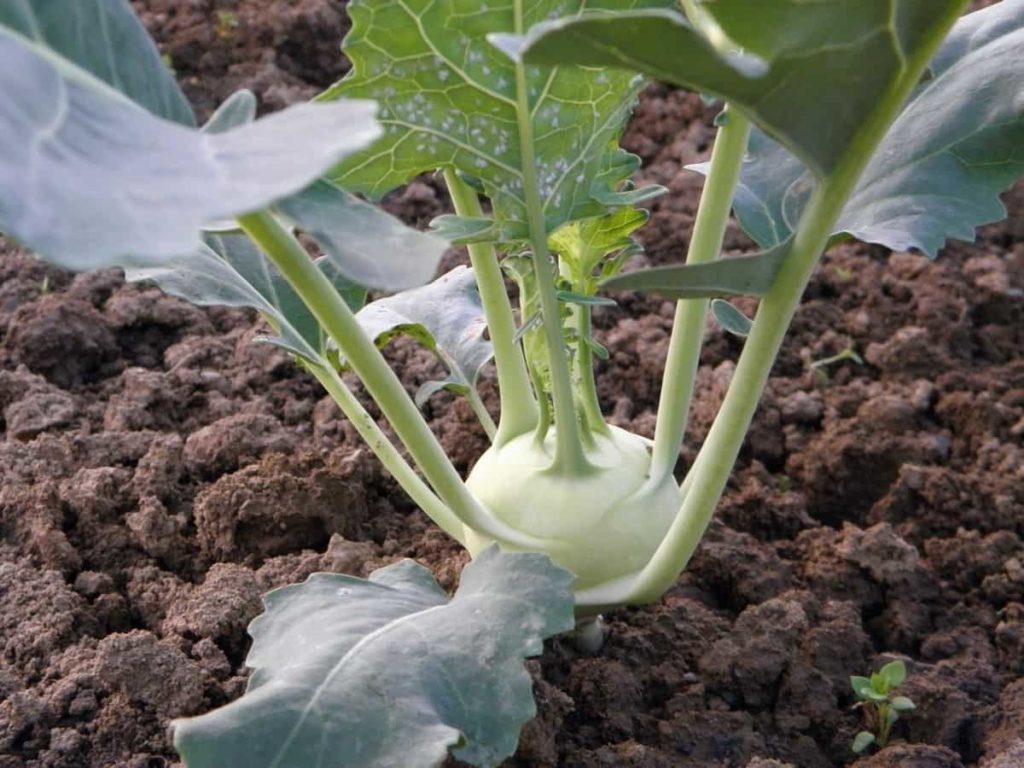
What fertilizer does Kohlrabi need?
- When they are actively growing, late spring or early summer is the best time to fertilize Kohlrabi. Use NPK fertilizers high in nitrogen (N) for good growth.
- Kohlrabi is a cold-weather vegetable that prefers sunny locations and fertile, well-drained soil. Add some organic matter and a complete fertilizer to the area before planting.
- Kohlrabi is a heavy feeder. It is better to continuously feed the plants by enriching the soil with amendments that improve the length rather than adding chemical fertilizers. Add manure when planting, and add side dress rows with compost until the harvest.
- Although side dresses its soil with 1 inch of manure before planting. Avoid planting Kohlrabi, where other vegetables have been grown in the Brassica family in the last 2 or 3 years.
- Kohlrabi is not a very heavy feeder. You should fertilize with 3 to 4 quarts per 100 square feet of good organic all-purpose 5-5-5 fertilizers about two weeks before sowing or transplantation is usually seen through harvesting in most gardens.
- Like all plants in the cabbage family, Kohlrabi performs best in rich, well-fertilized soils with a pH of 6.5 to 7 (slightly acidic but almost neutral). If you didn’t want to apply lime in the fall, work a handful of organic bone meal and a half cup of organic vegetable food into each planting hole.
- Use NPK fertilizers that are high in nitrogen for good growth. Balanced fertilizers like 20-20-20 can be used, but avoid using fertilizers that are very high in phosphorus (P), which can promote leaf growth at the expense of bulbs.
Does Kohlrabi need full sun?
- Kohlrabi, which matures in cool weather, is deliciously sweet. Kohlrabi requires at least 6 hours of full sunlight every day; Give it fertile, well-drained, moist soil with lots of rich organic matter. A soil pH between 6.5 and 6.8 discourages clubroot disease.
- Cole crops are tolerant of partial sun or part shade. Broccoli, Cauliflower, Kohlrabi, Turnip, Kale, and Rutabaga will grow well with less than a full day of sun, but they may take longer to mature. Cabbage will grow in the shade, but they can’t make a tight head.
- Cabbage, Cauliflower, Broccoli, Turnips, and varieties such as Kale and Kohlrabi have many gardening needs. It has an excellent performance in cold weather, between 19°C to 24°C, and when planted in fertile, moisture-enhancing soils.
How tall do Kohlrabi plants grow?
Kohlrabi can grow 6 to 18 inches long and 12 to 18 inches wide and produce bulbs up to 6 inches in diameter. Give them water as needed. Space giant Kohlrabi is four inches apart until their width is two inches, then harvest some of them so that there are 12 inches between the plants.
Can I grow Kohlrabi in pots?
- Kohlrabi is the best choice for container gardening. Just be sure to choose a large enough container and fill that container with a good potting soil mixture that contains a lot of nutrient-rich fertilizer.
- You can grow Kohlrabi in pots, but it should be at least 16 inches deep and wide. The plant needs the right temperature between 4°C to 23°C to grow well. You need to use suitable potting soil and harvest Kohlrabi when they are 3 to 4 inches in diameter.
In case you missed it: How to Start Carrot Farming in the USA: A Step-By-Step Production Guide for Planting to Harvesting
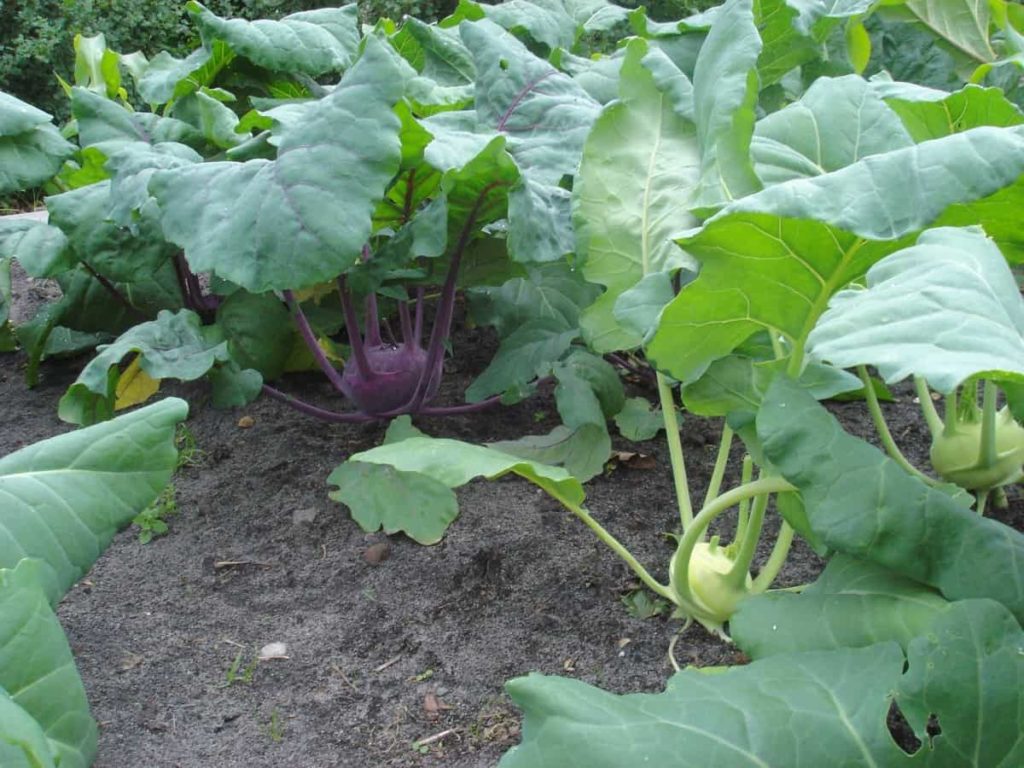
Should I remove Kohlrabi leaves?
- It’s also better to pick them up when they’re young because the leaves are slightly stiff with age. Then, for harvesting, cut the healthy outer leaves as needed, making sure no more than one-third of the plant will be removed at a time.
- It is unnecessary to trim the leaves back to grow Kohlrabi. You can cut some gentle young leaves to eat raw or cooked as you would kale or other greens.
- You can trim the leaves from the stem and save them for cooking separately. Kohlrabi stays in the fridge for 2 to 3 weeks.
Does Kohlrabi transplant well?
- Kohlrabi transplants well, and it’s a preferred way to increase your season in the spring. However, start your seeds indoors in early February, as Kohlrabi needs cool weather to thrive.
- If you plant Kohlrabi as a fall crop, sow seeds about 90 days before the first frost date. In the spring, transplant the Kohlrabi seedlings outside about 1 to 2 weeks before your last frost date. From mid-April to early May, seed Kohlrabi directly in the garden, an inch away and a quarter to a half inch deep. Avoid planting after May.
Why are my Kohlrabi leaves turning yellow?
- Water is the most common reason your plant’s leaves turn yellow, but it’s hard to understand whether you’re watering the plant more or less.
- You should apply copper dust or liquid copper spray every 7 to 10 days. The yellow spots on the outer leaves grow larger and become grayish-brown stripes. Early blight, or Cercospora leaf spot spread by heavy rain and hot temperatures. Keep down the weeds in the garden area; they contain fungus spores.
When can I plant Kohlrabi indoors?
- If you start it indoors, wait until the baby Kohlrabi plants are 4 to 6 weeks old before transplanting them into the garden soil you’ve prepared outside. Start 6 to 8 weeks before planting the seeds to start indoors. Sow the seeds 1/4 inch deep and transplant them to the garden at a distance of 6 to 8 inches.
- You can sow under cloches or fleece from late February to early March, in open ground from spring to mid-summer, or in warmer areas until mid-August. Sow very little and often every three weeks for a steady supply.
- Start seeding indoors in early April or four to six weeks before transplantation. Cold room temperatures between 15°C to 23°C and bright overhead light will result in excellent plant growth.
Will Kohlrabi grow back after harvesting?
- Kohlrabi is a biennial grown as an annual. Kohlrabi has a swollen globe-shaped stem that looks like a turnip growing on the root of a cabbage. The stems can be white, purple, or green and are topped with a rosette of long blue-green leaves.
- If you leave the bottom of the stem in the ground, a Kohlrabi plant will grow back after harvesting. However, it is technically a biennial. This means it will set flowers and seeds a second year instead of producing another edible stem.
In case you missed it: 19 Key Rules for Effective Crop Management: A Profitable Agricultural Tips for Beginners
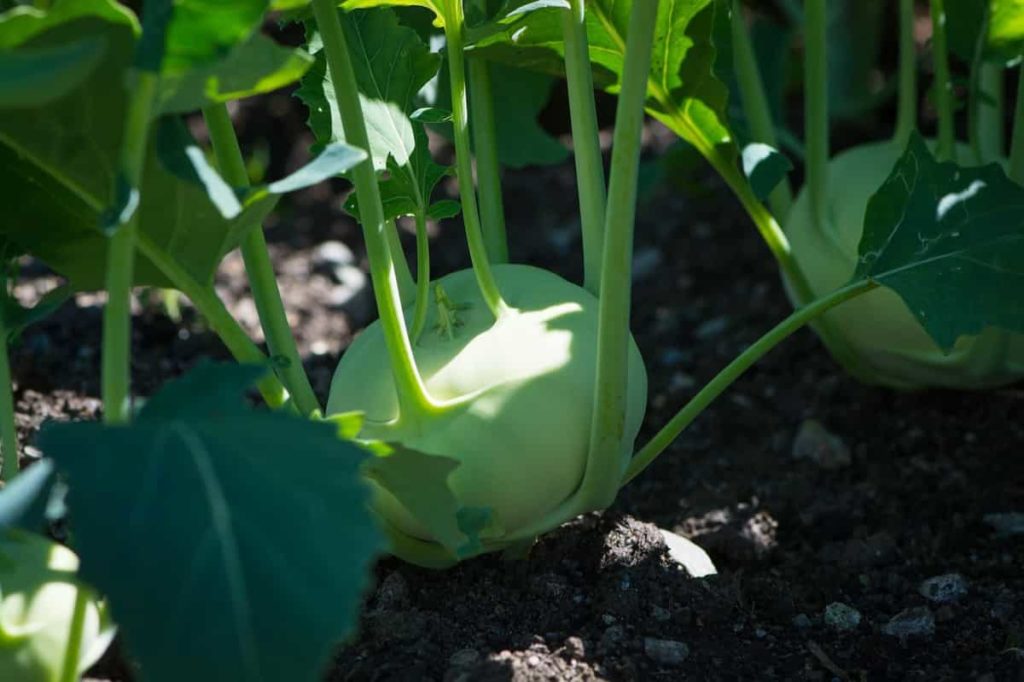
How do I know when Kohlrabi is ready to harvest?
- When the Kohlrabi bulb reaches 1 to 3 inches in diameter or about the size of a tennis ball, Kohlrabi is ready for harvesting. Do not pick vegetables in hot weather because the root becomes wooden. Kohlrabi leaves are also edible.
- When they are still young and soft, harvest Kohlrabi stems are usually about 2 1/2 to 4 inches in diameter. Cut them from the base of the plant and harvest them. You can trim the leaves from the stem and save them for cooking separately.
- Many gardeners allow Kohlrabi to grow too big before harvesting. The large, old Kohlrabi is hard and woody and may have an off-flavor. When the first stems are about an inch in diameter, start harvesting (pull or cut at the surface of the ground). Continue the crop until the stems are 2 to 3 inches in diameter.
- Don’t wait until they’re big, and big isn’t better. If you grow them too big, they’ll be hard and grainy, don’t taste so good, and eventually become inedible.
Why is my Kohlrabi bolting?
- Kohlrabi also grows best in cold weather, like cruciferous vegetables such as Broccoli and Brussels sprouts. When the summer temperature comes, the humidity increases. Plants that you didn’t arrive around harvest will be prompted by warm weather to bolt or produce flowers, due to warm weather.
- Kohlrabi is the least hardy of cabbage, like vegetables. Due to the hot weather, the stem becomes woody and hard.
Why is my Kohlrabi splitting?
The splitting of the swollen stem normally represents rapid vegetative growth. However, if the plant experiences a drought followed by severe water or rain, the rapid growth of the plant can cause splitting combined with an overdose of water.
Do you need to cover Kohlrabi?
- Make a groove about 1 to 2 centimeters deep in the soil and sow a seed in them every 2 inches. Cover with a well of soil and water. If more than one row is placed, the rows should be 10 inches apart at their distance. The seedlings will appear in about ten days and should be thinned at a distance of 1 foot apart.
- Applying organic mulch will help conserve water and keep the soil cool. Fertilizing Kohlrabi plants with proper nitrogen fertilizer helps ensure plants’ faster growth. Kohlrabi beds should be kept weed-free by cultivating the soil around plants, especially when the plants are small.
In case you missed it: Top 15 Steps/Ways to Boost Eggplant/Brinjal Yield: How to Increase Production, Size, and Quality
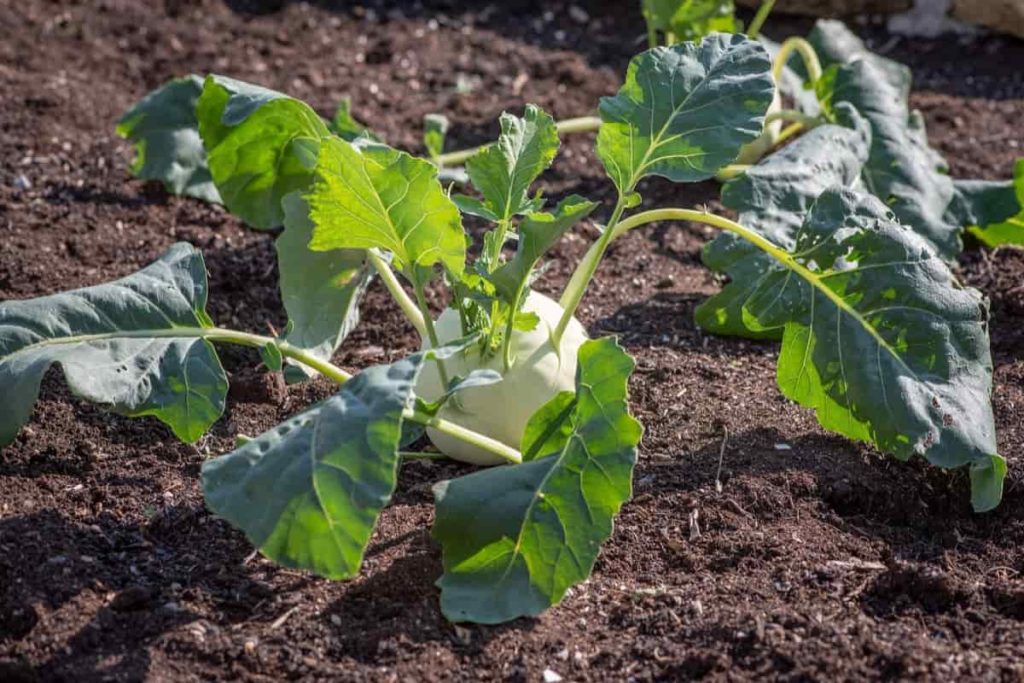
Can Kohlrabi get too big?
- Yes, Kohlrabi can be big if you don’t pull it off at the right time. It won’t be easy to eat if it gets too large, and the taste will be less desirable.
- Kohlrabi is ready for harvesting when its bulb is 2 to 3 inches in diameter or about the size of a tennis ball. Do not pick vegetables in hot weather because the root becomes wooden.
What kind of soil do you need for Kohlrabi?
- Grow Kohlrabi in loamy, well-drained soil with more organic matter. You can grow acceptable crops on heavier soil as long as they are well-drained and on sandy soil if you water them frequently. A neutral soil pH of 6.0 to 7.5 is ideal for growing Kohlrabi.
- Even though Kohlrabi isn’t a root vegetable, it craves similar growing conditions that you’d give Carrots or Radishes: moist, rich loam. Double digging or raised beds yield Kohlrabi bulbs with tender, non-pithy flesh.
Conclusion
Kohlrabi’s growing is easy, even for novices. Gardeners who can’t wait to jump on the weather should add Kohlrabi to their early performers, such as Peas and Radishes. Kohlrabi is very cold tolerant; ideally, the soil temperature should be finished with its growing cycle before it warms. Unfortunately, Kohlrabi is seriously low-rated as a vegetable.
It is the same variety as kale, Broccoli, Cauliflower, Cabbage, and Collard, but hardly anyone grows it, and it is seen as a curiosity in the supermarket more than an important one in the kitchen. But Kohlrabi is a versatile, delicious vegetable that tastes much better when you grow it yourself.
- Economical Aquaculture: A Guide to Low-Budget Fish Farming
- 15 Common Planting Errors That Can Doom Your Fruit Trees
- How to Make Houseplants Bushy: Effective Tips and Ideas
- Innovative Strategies for Boosting Coconut Pollination and Yield
- Pollination Strategies for Maximum Pumpkin Yield
- The Complete Guide to Chicken Fattening: Strategies for Maximum Growth
- Natural Solutions for Tulip Problems: 100% Effective Remedies for Leaf and Bulb-Related Issues
- Revolutionizing Citrus Preservation: Towards a Healthier, Greener Future
- Natural Solutions for Peony Leaf and Flower Problems: 100% Effective Remedies
- Maximizing Profits with Avocado Contract Farming in India: A Comprehensive Guide
- Natural Solutions for Hydrangea Problems: 100% Effective Remedies for Leaf and Flowers
- The Ultimate Guide to Choosing the Perfect Foliage Friend: Bringing Life Indoors
- From Sunlight to Sustainability: 15 Ways to Use Solar Technology in Agriculture
- The Ultimate Guide to Dong Tao Chicken: Exploring from History to Raising
- The Eco-Friendly Makeover: How to Convert Your Unused Swimming Pool into a Fish Pond
- Mastering the Art of Delaware Chicken Farming: Essentials for Healthy Backyard Flocks
- 20 Best Homemade Fertilizers for Money Plant: DIY Recipes and Application Methods
- How to Craft a Comprehensive Free-Range Chicken Farming Business Plan
- Brighten Your Flock: Raising Easter Egger Chickens for Beauty and Bounty
- How to Optimize Your Poultry Egg Farm Business Plan with These Strategies
- Subsidy for Spirulina Cultivation: How Indian Government Schemes Encouraging Spirulina Farmers
- Ultimate Guide to Raising Dominique Chickens: Breeding, Feeding, Egg-Production, and Care
- Mastering the Art of Raising Jersey Giant Chickens: Care, Feeding, and More
- Ultimate Guide to Raising Legbar Chickens: Breeding, Farming Practices, Diet, Egg-Production
- How to Raise Welsummer Chickens: A Comprehensive Guide for Beginners
- How to Protect Indoor Plants in Winter: A Comprehensive Guide
- Ultimate Guide to Grow Bag Gardening: Tips, Tricks, and Planting Ideas for Urban Gardeners
- Guide to Lotus Cultivation: How to Propagate, Plant, Grow, Care, Cost, and Profit
- Agriculture Drone Subsidy Scheme: Government Kisan Subsidy, License, and How to Apply Online
- Ultimate Guide to Raising Araucana Chickens: Breed Profile, Farming Economics, Diet, and Care
- Bringing Hydroponics to Classroom: Importance, Benefits of Learning for School Students
- Ultimate Guide to Raising Polish Chickens: Breed Profile, Farming Economics, Diet, and Care
- Ultimate Guide to Raising Australorp Chickens: Profile, Farming Economics, Egg Production, Diet, and Care
- Silkie Chicken Farming: Raising Practices, Varieties, Egg Production, Diet, and Care
- Sussex Chicken Farming: Raising Practices, Varieties, Egg Production, Diet and Care
- Homemade Feed Formulations for Livestock: Discover Cost-effective Starter to Finisher Feed Recipes